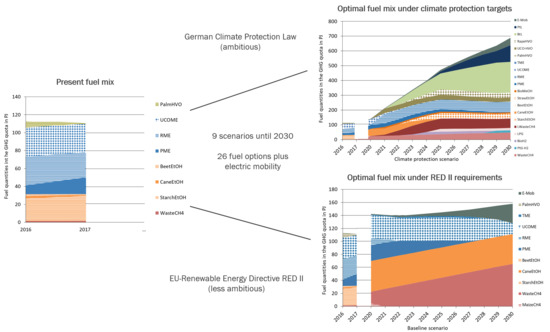Future Renewable Fuel Mixes in Transport in Germany under RED II and Climate Protection Targets
Abstract
:1. Introduction
- In the case of a direct implementation of the EU RED II framework and under other varying frame assumptions into the German GHG based quota by 2030, which optimal fuel mixes and GHG emissions emerge?
- Which optimal fuel mix and measures would be required to reach the target of the German climate protection target in transport by 2030?
2. Materials and Methods
2.1. Fuel Options
- Advanced biofuels (from feedstocks according to Annex IX, Part A of RED II)
- Biofuels from used cooking oil and animal fats (according to Annex IX, Part B of RED II)
- Conventional biofuels from food and feed crops
- Renewable non-biogenic fuels (power-to X (PtX)-options)
- E-vehicles in road transport
- Fossil fuel options such as liquefied natural gas (LNG), compressed natural gas (CNG), liquefied petroleum gas (LPG) and H2 from fossil fuels.
2.2. Scenarios
2.3. Modelling
2.4. Data and Assumptions
- Upstream Emission Reduction (UER) measures according to [33] and electricity in rail transport are out of scope.
- The development of electric mobility is set exogenously and integrated into the fuel mix without competition, and is thus not part of the modelling.
- The electricity available for electric mobility and for the production of electricity-based fuels is not limited.
- Grid electricity is used for the use of electric mobility. Only the share of renewable energies in the electricity mix is counted towards the GHG quota.
- According to RED II, the use of electricity in road transport is credited to the GHG quota by four times its energy content.
- The production of electricity-based fuels takes place in favoured areas for the production of renewable energies. It is assumed that this electricity is generated at 0.05 Euro/kWh [37].
- Advanced biofuels from feedstocks according to Annex IX, Part A of RED II are considered to be twice their energy content in the GHG quota. The minimum share for them without double counting is 0.1% in 2021, 0.5% in 2025 and 1.75% in 2030 of the final energy consumption, according to RED II [7].
- The share of fuels with a high risk of indirect land-use change (e.g., palm oil-based fuels) will be set to 0% by the end of 2030, in accordance with RED II [7] (so-called phase-out).
- The share of methane gas in the fuel mix increases from 1% in 2020 to 3% of the final energy consumption in 2030.
- For crops, the prices were calculated in reference to a wheat price baseline according to a methodology elaborated in [38], where all crops have to achieve the same profit per hectare as the baseline crop, considering differing production costs and yields.
- To avoid additional uncertainties, annual increases in feedstock prices, energy taxes and economic learning effects resulting from cumulatively constructed plants are not taken into account in Scenarios 1–3 and 5–9.
- The GHG emissions decrease fuel-specifically until 2030, assuming an increasing share of renewable energies and increasing efficiencies in the upstream and main chain technologies.
- The efficiencies of the technologies develop according to their maturity levels until 2030.
- Biomass imports are possible for Scenarios 1–8. The biogenic residues wood, straw, used food and animal fats can be used up to 2.5 times the domestic potential, under the assumption that (i) these goods have a high enough energy density to be economically and viably transported, and (ii) they are available from and in neighbouring countries. The allowed arable land area for biofuel production of 2 million hectares is based on the recent arable land usage for this purpose [39]. This area sets the upper limit for how much is allowed to be used in the model; what is grown on the area is decided endogenously within the model, and the area does not have to be used.
- Direct fuel imports are limited to the current level of globally traded volumes, e.g., for sugarcane ethanol.
- The maximum annual fuel capacity increase of the fuel production facilities is 50% and 0.1 PJ for advanced fuels that did not have any production capacity in the previous year.
- Biodiesel from animal fats is not excluded from the GHG quota in Germany, as was previously the case. However, the starting capacities for scenario modelling are set to zero for the model base year 2016.
- Mobilisable technical potentials for feedstocks are taken into account according to the DBFZ resource database [40].
- The fuel quantities for 2016 and 2017 shown in the fuel mix diagrams of the scenarios are taken from the evaluation and experience report of the German Federal Agency for Agriculture and Food [41].
- The plant capacities of the base year 2016 were taken from [42].
- The specific GHG emissions for the fuels reported so far in the GHG quota were taken from [41]. For the other fuels, the GHG values were taken from Annex V of RED II [7]. The GHG values for electricity-based fuels and fossil fuels were taken from the thirty-eighth Federal Emissions Control Act [27].
3. Results
3.1. Baseline Scenario
3.2. Climate Protection Scenario
3.3. Results of the Other Scenarios
4. Discussions
5. Conclusions
Supplementary Materials
Author Contributions
Funding
Acknowledgments
Conflicts of Interest
References
- International Panel of Climate Change. Summary for Policymakers. In Global Warming of 1.5 °C. an IPCC Special Report on the Impacts of Global Warming of 1.5 °C above Pre-Industrial Levels and Related Global Greenhouse Gas Emission Pathways, in the Context of Strengthening the Global Response to the Threat of Climate Change, Sustainable Development, and Efforts to eradicate Poverty; International Panel of Climate Change: Geneva, Switzerland, 2018. [Google Scholar]
- International Panel of Climate Change. Climate Change and Land: An IPCC Special Report on Climate Change, Desertification, Land Degradation, Sustainable Land Management, Food Security, and Greenhouse Gas Fluxes in Terrestrial Ecosystems, Summary for Policy Makers; International Panel of Climate Change: Geneva, Switzerland, 2019. [Google Scholar]
- United Nations. Paris Agreement; United Nations: New York, NY, USA, 2015. [Google Scholar]
- Agora Energiewende. The German Power Market: State of Affairs in 2019; Agora Energiewende: Berlin, Germany, 2020. [Google Scholar]
- Federal Ministry for the Environment, Nature Conservation and Nuclear Safety. Climate Protection in Figures: The Transport Sector; Federal Ministry for the Environment, Nature Conservation and Nuclear Safety: Bonn, Germany, 2019. [Google Scholar]
- Federal Ministry of Transport and Digital Infrastructure. Transport in Figures 2019/2020. 48. Jahrgang; Federal Ministry of Transport and Digital Infrastructure: Berlin, Germany, 2019. [Google Scholar]
- European Parliament and Council of the European Union. Directive (EU) 2018/2001 of the European Parliament and of the Council of 11 December 2018 on the Promotion of the Use of Energy from Renewable Sources (Recast): RED II; European Parliament and Council of the European Union: Brussels, Belgium, 2018.
- European Parliament and Council of the European Union. Regulation (EU) 2018/842 of the European Parliament and of the Council of 30 May 2018 On binding Annual Greenhouse Gas Emission Reductions by Member States from 2021 to 2030 Contributing to Climate Action to Meet Commitments under the Paris Agreement and amending Regulation (EU) No 525/2013; European Parliament and Council of the European Union: Brussels, Belgium, 2018.
- Federal Ministry for the Environment, Nature Conservation and Nuclear Safety. Climate Protection Plan 2050: Climate Protection Policy Principles and Goals of the Federal Government; Federal Ministry for the Environment, Nature Conservation and Nuclear Safety: Bonn, Germany, 2016. [Google Scholar]
- Federal Ministry for the Environment, Nature Conservation and Nuclear Safety. Climate Protection Programme 2030 of the Federal Government to implement the Climate Protection Plan 2050; Federal Ministry for the Environment, Nature Conservation and Nuclear Safety: Bonn, Germany, 2019. [Google Scholar]
- European Parliament and Council of the European Union. Directive 2009/28/Ec of the European Parliament and of the Council of 23 April 2009 on the Promotion of the use of Energy from Renewable Sources and Amending and Subsequently Repealing Directives 2001/77/EC and 2003/30/EC; European Parliament and Council of the European Union: Brussels, Belgium, 2009.
- European Parliament and Council of the European Union. Directive 2009/30/ec of the European Parliament and of the Council of 23 April 2009 Amending Directive 98/70/EC as Regards the Specification of Petrol, Diesel and Gas-Oil and Introducing a Mechanism to Monitor and Reduce Greenhouse gas Emissions and Amending Council Directive1999/32/EC as Regards the Specification of Fuel Used by Inland Waterway Vessels and Repealing Directive 93/12/EEC; European Parliament and Council of the European Union: Brussels, Belgium, 2009.
- Naumann, K.; Schröder, J.; Müller-Langer, F.; Oehmichen, K.; Remmele, E.; Thundeke, K.; Etzold, H.; Rakshy, T.; Schmidt, P. Monitoring Biokraftstoffsektor, 4th ed.; DBFZ Deutsches Biomasseforschungszentrum gemeinnützige GmbH: Leipzig, Germany, 2019. [Google Scholar]
- Deutsche Energie-Agentur GmbH. Dena Study. Integrated Energy Transition: Impulses to Shape the Energy System up to 2050, Report of the Results and Recommended Course of Action; Deutsche Energie-Agentur GmbH. Dena Study: Berlin, Germany, 2018. [Google Scholar]
- Leopoldina; acatech; UNION der Deutschen Akademien der Wissenschaften; BDI; Dena. Focusing Expertise, Shaping Policy—Energy transiTion Now! Essential Findings of the Three Baseline Studies into the Feasibility of the Energy Transition by 2050 in Germany. 2019. Available online: https://www.dena.de/fileadmin/dena/Dokumente/Themen_und_Projekte/Energiesysteme/dena-Leitstudie/2019-08-28_Studienvergleich_ENG.pdf (accessed on 2 April 2020).
- Öko-Institut e.V.; Fraunhofer ISI. Climate Protection Scenario 2050; Öko-Institut e.V.: Freiburg, Germany, 2016. [Google Scholar]
- Leopoldina; acatech; UNION der Deutschen Akademien der Wissenschaften. Coupling the Different Energy Sectors—Options for the Next Phase of the Energy Transition; 2018; Available online: https://energiesysteme-zukunft.de/en/publications/position-paper/coupling-the-different-energy-sectors/ (accessed on 2 April 2020).
- Boston Consulting Group (BCG), Prognos. Climate Paths for Germany; Boston Consulting Group (BCG), Prognos: Boston, MA, USA, 2018. [Google Scholar]
- Agora Energiewende. Climate Protection in Transport: Measures to Achieve the Sectoral Target for 2030; Agora Energiewende: Berlin, Germany, 2018. [Google Scholar]
- European Commission. EU Reference Scenario 2016: Energy, Transport and GHG Emissions, Trends to 2050; European Commission: Brussels, Belgium, 2016. [Google Scholar]
- Öko-Institut, e.V.; DLR; IFEU; INFRAS AG. RENEWBILITY III: Options for Decarbonising the Transport Sector; Öko-Institut e.V.: Freiburg, Germany, 2016. [Google Scholar]
- Umweltbundesamt. Climate Protection in Transport—Need for Action in the Wake of the Paris Climate Agreement: Report as Part of the Project Climate Change Mitigation in Transport until 2050. 2017. Available online: https://www.google.com.hk/url?sa=t&rct=j&q=&esrc=s&source=web&cd=1&ved=2ahUKEwimjbXh0cvoAhUHw4sBHW2WAJUQFjAAegQIAxAB&url=https%3A%2F%2Fwww.umweltbundesamt.de%2Fsites%2Fdefault%2Ffiles%2Fmedien%2F1410%2Fpublikationen%2F2017-11-03_texte_97-2017_climate-protection-transport.pdf&usg=AOvVaw3GzusK1a-z3T6e46ZbsvJo (accessed on 2 April 2020).
- Umweltbundesamt. Greenhouse-Gas-Nautrality in Germany until 2050: Policy Paper to the RESCUE-Study. 2019. Available online: https://www.google.com.hk/url?sa=t&rct=j&q=&esrc=s&source=web&cd=1&ved=2ahUKEwi_x4aV0svoAhU1zIsBHbq2CJUQFjAAegQIBRAB&url=https%3A%2F%2Fwww.umweltbundesamt.de%2Fen%2Frescue%2Fbackground-greenhouse-gas-neutrality&usg=AOvVaw13hYXbzWQNvOkeUsX1jr1I (accessed on 2 April 2020).
- Federal Network Agency and Federal Cartel Office. Monitoring Report 2018; Federal Network Agency and Federal Cartel Office: Paris, France, 2019.
- Wietschel, M.; Kluschke, P.; Oberle, S.; Ashley-Belbin, N. Overview Study: Evaluation of Studies and Scenarios of Energy System Analysis with Focus on “Mobility”; 2018; Available online: https://um.baden-wuerttemberg.de/fileadmin/redaktion/m-um/intern/Dateien/Dokumente/5_Energie/SDA/Studie_Energiesystemanalyse_Mobilitaet.pdf (accessed on 4 March 2020).
- Federal Government. Thirty-seventh Ordinance on the Implementation of the Federal Immission Control Act (Verordnung zur Anrechnung von Strombasierten Kraftstoffen und Mitverarbeiteten Biogenen Ölen auf die Treibhausgasquote 37. BimSchV); Federal Government: Washington, DC, USA, 2017.
- Federal Government. Thirty-Eighth Ordinance on the Implementation of the Federal Immission Control Act (Verordnung zur Festlegung Weiterer Bestimmungen zur Treibhausgasminderung bei Kraftstoffen—38. BImSchV); Federal Government: Washington, DC, USA, 2017.
- German Institute for Standardization e.V. DIN EN 590:2017-10, 2017: Kraftstoffe Dieselkraftstoff Anforderungen und Prüfverfahren. Deutsche Fassung EN 590:2013+A1:2017; German Institute for Standardization e.V.: Berlin, Germany, 2017. [Google Scholar]
- German Institute for Standardization e.V. DIN EN 228:2017-08, 2017: Kraftstoffe Unverbleite Ottokraftstoffe-Anforderungen und Prüfverfahren, Deutsche Fassung EN 228:2012+A1:2017; German Institute for Standardization e.V.: Berlin, Germany, 2017. [Google Scholar]
- German Institute for Standardization e.V. Automotive Fuels-Paraffinic Diesel Fuel from Synthesis or Hydrotreatment Requirements and Test Methods, German Version EN 15940:2016+A1:2018+AC:2019; German Institute for Standardization e.V.: Berlin, Germany, 2019. [Google Scholar]
- Kreyenberg, D.; Lischke, A.; Bergk, F.; Duennebeil, F.; Heidt, C.; Knörr, W.; Raksha, T.; Schmidt, P.; Weindorf, W.; Naumann, K.; et al. Renewable Energies in Transport. Potentials and Development Perspectives of Different Renewable Energy Sources and Energy Consumption of the Transport Modes; Berlin, Germany, 2015; Available online: https://www.bmvi.de/SharedDocs/DE/Anlage/G/MKS/mks-kurzstudie-ee-im-verkehr.pdf?__blob=publicationFile (accessed on 3 April 2020).
- CDU, CSU, SPD. Coalition Agreement between CDU, CSU und SPD. 2018. Available online: https://www.cdu.de/sites/default/files/media/dokumente/koalitionsvertrag.pdf (accessed on 2 April 2020).
- Federal Government. Ordinance on the Crediting of Upstream Emission Reductions against the Greenhouse Gas Quota (Upstream-EmissionsminderungsVerordnung UERV); Federal Government: Washington, DC, USA, 2018.
- Millinger, M.; Meisel, K.; Thrän, D. Greenhouse gas abatement optimal deployment of biofuels from crops in Germany. Transp. Res. Part D Transp. Environ. 2019, 2019, 265–275. [Google Scholar] [CrossRef]
- Millinger, M. Systems Assessment of Biofuels. Modelling of Future Cost and Greenhouse Gas Abatement Competitiveness between Biofuels for Transport on the Case of Germany. Ph.D. Thesis, Universität Leipzig, Leipzig, Germany, 2018. [Google Scholar]
- Millinger, M.; POnitka, J.; Arendt, O.; Thrän, D. Competitiveness of advanced and conventional biofuels: Results from least-cost modelling of biofuel competition in Germany. Energy Policy 2017, 2017, 394–402. [Google Scholar] [CrossRef]
- Schmidt, P.R.; Zittel, W.; Weindorf, W.; Raksha, T. Renewables in Transport 2050: Empowering a Sustainable Mobility Future with zero Emission Fuels from Renewable Electricity; Frankfurt am Main, Germany, 2016; Available online: http://www.lbst.de/news/2016_docs/FVV_H1086_Renewables-in-Transport-2050-Kraftstoffstudie_II.pdf (accessed on 3 April 2020).
- Millinger, M.; Thrän, D. Biomass price developments inhibit biofuel investments and research in Germany: The crucial future role of high yields. J. Clean. Prod. 2018, 2018, 1654–1663. [Google Scholar] [CrossRef]
- Fachagentur für Nachwachsende Rohstoffe e.V. Entwicklung der Anbaufläche für Nachwachsende Rohstoffe; Fachagentur für Nachwachsende Rohstoffe e.V.: Gulzow, Germany, 2019. [Google Scholar]
- Deutsches Biomasseforschungszentrum Gemeinnützige GmbH. DBFZ Ressourcendatenbank. Available online: Webapp.dbfz.de (accessed on 2 April 2020).
- Federal Agency for Agriculture and Food. Evaluation and Experience Report for 2017; Federal Agency for Agriculture and Food: Bonn, Germany, 2018. [Google Scholar]
- Naumann, K.; Oehmichen, K.; Remmele, E.; Thuneke, K.; Schröder, J.; Zeymer, M.; Meisel, K. Monitoring Biokraftstoffsektor, 3rd ed.; Biomasseforschungszentrum: Leipzig, Germany, 2016. [Google Scholar]
- Jens, P.; Oliver, A.; Volker, L.; Jaqueline, D.; Walter, S.; Andreas, O.; Martin, Z.; Arne, G.; Franziska, M.; Marco, K.; et al. Bioenergy Technologies: Conversion Paths for Energetic Biomass Use in the 21st Century; 2015; Available online: https://www.energetische-biomassenutzung.de/fileadmin/media/6_Publikationen/fh_technologie_web_small.pdf (accessed on 3 April 2020).
- Zech, K.; Grasemann, E.; Oehmichen, K.; Kiendl, I.; Schmersahl, R.; Rönsch, S.; Seiffert, M.; Müller-Langer, F.; Weindorf, W.; Funke, S.; et al. HY-NOW. Evaluation of Processes and Technologies for the Supply of Hydrogen Based on Biomass; Leipzig, Germany, 2014; Available online: https://www.dbfz.de/fileadmin/user_upload/Referenzen/DBFZ_Reports/DBFZ_Report_19.pdf (accessed on 3 April 2020).
- Dietrich, S.; Oehmichen, K.; Zech, K.; Müller-Langer, F.; Majer, S.; Kalcher, J.; Naumann, K.; Wirkner, R.; Pujan, R.; Braune, M.; et al. Feasibility Analysis for a PTG HEFA Hybrid Refinery in Germany; Leipzig, Germany, 2017; Available online: https://www.bmvi.de/SharedDocs/DE/Anlage/G/MKS/machbarkeitsanalyse-ptg-hefa-hybridraffinerie.pdf?__blob=publicationFile (accessed on 3 April 2020).
- Müller-Langer, F. Analyse und Bewertung Ausgewählter Zukünftiger Biokraftstoffoptionen auf der Basis Fester Biomasse: DBFZ Report Nr. 9; Technische Universität Hamburg-Harburg: Hamburg, Germany, 2012. [Google Scholar]
- Majer, S.; Helka, J.; Etzold, H. Assessment of Biomass Potentials from Waste and Residues for Advanced Fuels: Potentials; Economic and Environmental Performance: Leipzig, Germany, 2018. [Google Scholar]
- Losordo, Z.; McBride, J.; van Hooyen, J.; Wenger, K.; Willies, D.; Froehlich, A.; Macedo, I.; Lynd, L. Cost competitive second-generation ethanol production from hemicellulose in a Brazilian sugarcane biorefinery. Biofpr 2016, 10, 589–602. [Google Scholar] [CrossRef]
- Food and Agriculture Organization of the United Nations. FAOSTAT. Production of Crops. Available online: http://www.fao.org/faostat/en/#data/QC (accessed on 4 March 2020).
- Europäische Kommission. EUROSTAT. Energiestatistik. Available online: https://ec.europa.eu/eurostat/de/data/database (accessed on 4 March 2020).
- F.O. Licht. Plants & Projects. In F.O. Lichts World Ethanol & Biofuels Report, Volumes in the year 2013–2017. Available online: https://www.agra-net.com/agra/world-ethanol-and-biofuels-report/ (accessed on 4 October 2017).
- Agrarmarkt Informations-Gesellschaft mbH. Available online: https://www.agrarheute.com/tag/agrarmarkt-informations-gesellschaft-mbh-ami (accessed on 27 November 2018).
- finanzen.net. Rohstoffe. Available online: https://www.finanzen.net/rohstoffe (accessed on 26 November 2018).
- top agrar online. Nachrichten und Preise für die Landwirtschaft. Available online: https://www.topagrar.com/ (accessed on 2 April 2020).
- Methanex. Methanex Methanol Price Sheet. Available online: https://www.methanex.com/sites/default/files/methanol-price/Mx-Price-Sheet%20-%20Feb%2028%2C%202019.pdf (accessed on 27 November 2018).
- C.A.R.M.E.N. Preisentwicklung bei Waldhackschnitzeln. Available online: https://www.forstpraxis.de/waldhackschnitzel-preise/ (accessed on 27 March 2019).
- Federal Agency for Agriculture and Food. Evaluation and experience report for 2018: Biomassestrom-Nachhaltigkeitsverordnung Biokraftstoff-Nachhaltigkeitsverordnung; Federal Agency for Agriculture and Food: Bonn, Germany, 2019. [Google Scholar]
- Federal Environment Agency. Development of Electricity Consumption by Sector. 2019. Available online: https://www.umweltbundesamt.de/daten/energie/stromverbrauch (accessed on 3 April 2020).
- Bundesregierung. Gesetz zur Einführung eines Bundes-Klimaschutzgesetzes und zur Änderung weiterer Vorschriften vom 12.12.2019. 2019. Available online: https://www.bgbl.de/xaver/bgbl/start.xav?startbk=Bundesanzeiger_BGBl&start=//*[@attr_id=%27bgbl119s0010.pdf%27]#__bgbl__%2F%2F*%5B%40attr_id%3D%27bgbl119s2513.pdf%27%5D__1585554588506 (accessed on 2 April 2020).
- Thrän, D.; Schaubach, K.; Majer, S.; Horschig, T. Governance of sustainability in the Germanbiogas sector—adaptive management ofthe Renewable Energy Act betweenagriculture and the energy sector. Energy Sustain. Soc. 2020, 10, 3. [Google Scholar] [CrossRef]
- Brosowski, A.; Bill, R.; Thrän, D. Transport of Goods Powered by Cereal Straw: Temporal and Spatial Biomass Availability for Future Bio-LNG Production in Germany. Energy Sustain. Soc. Submiss. in press.
- Moosmann, D.; Majer, S.; Ugarte, S.; Ladu, L.; Wurster, S.; Thrän, D. Strengths and gaps of the EU frameworks for the sustainability assessment of biobased products and bioenergy. Energy Sustain. Soc. Submiss. in press.
- Majer, S.; Wurster, S.; Moosmann, D.; Ladu, L.; Sumfleth, B.; Thrän, D. Gaps and Research Demand for Sustainability Certification and Standardisation in a Sustainable Bio-Based Economy in the EU. Sustainability 2018, 10, 2455. [Google Scholar] [CrossRef] [Green Version]
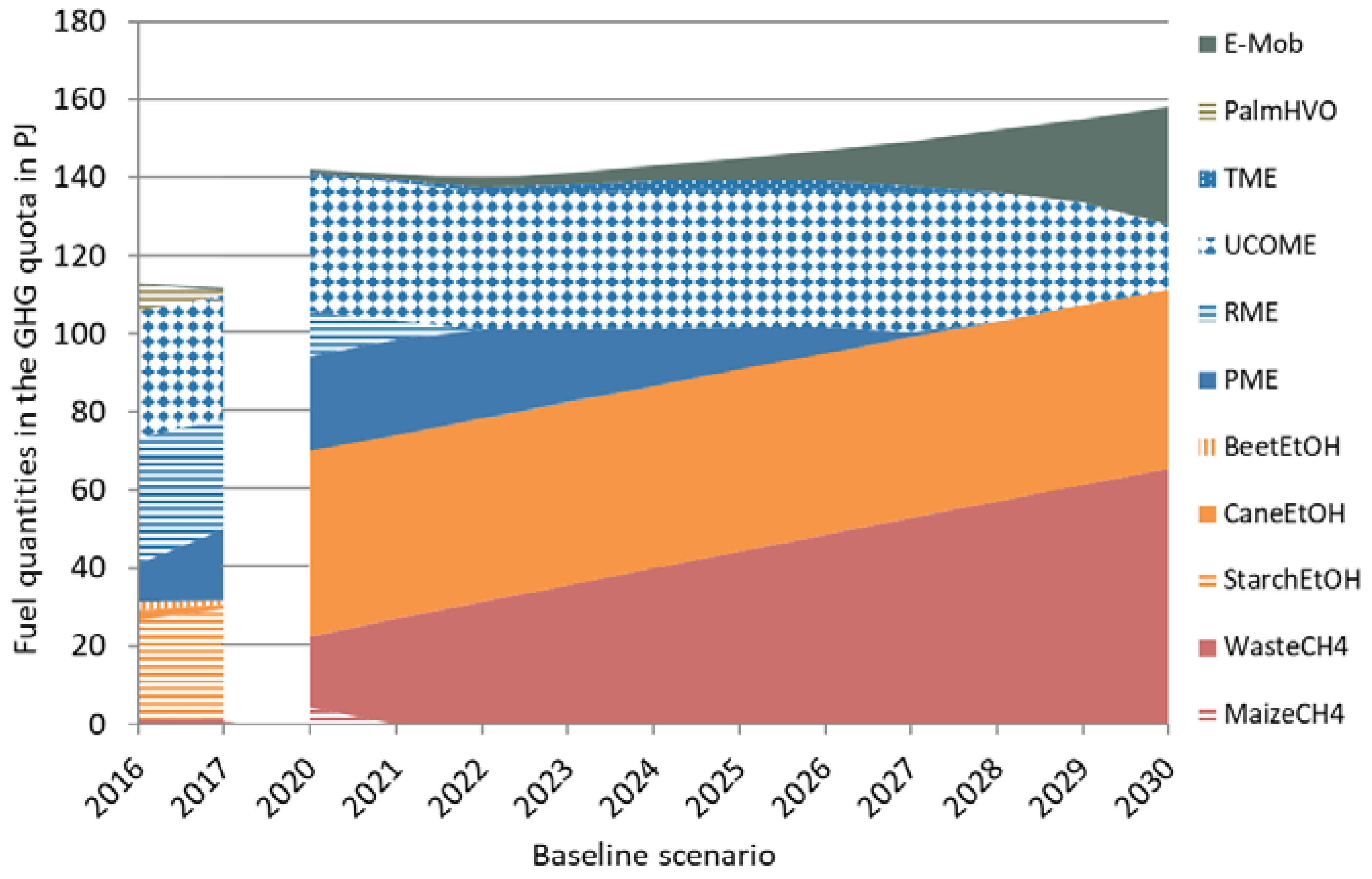
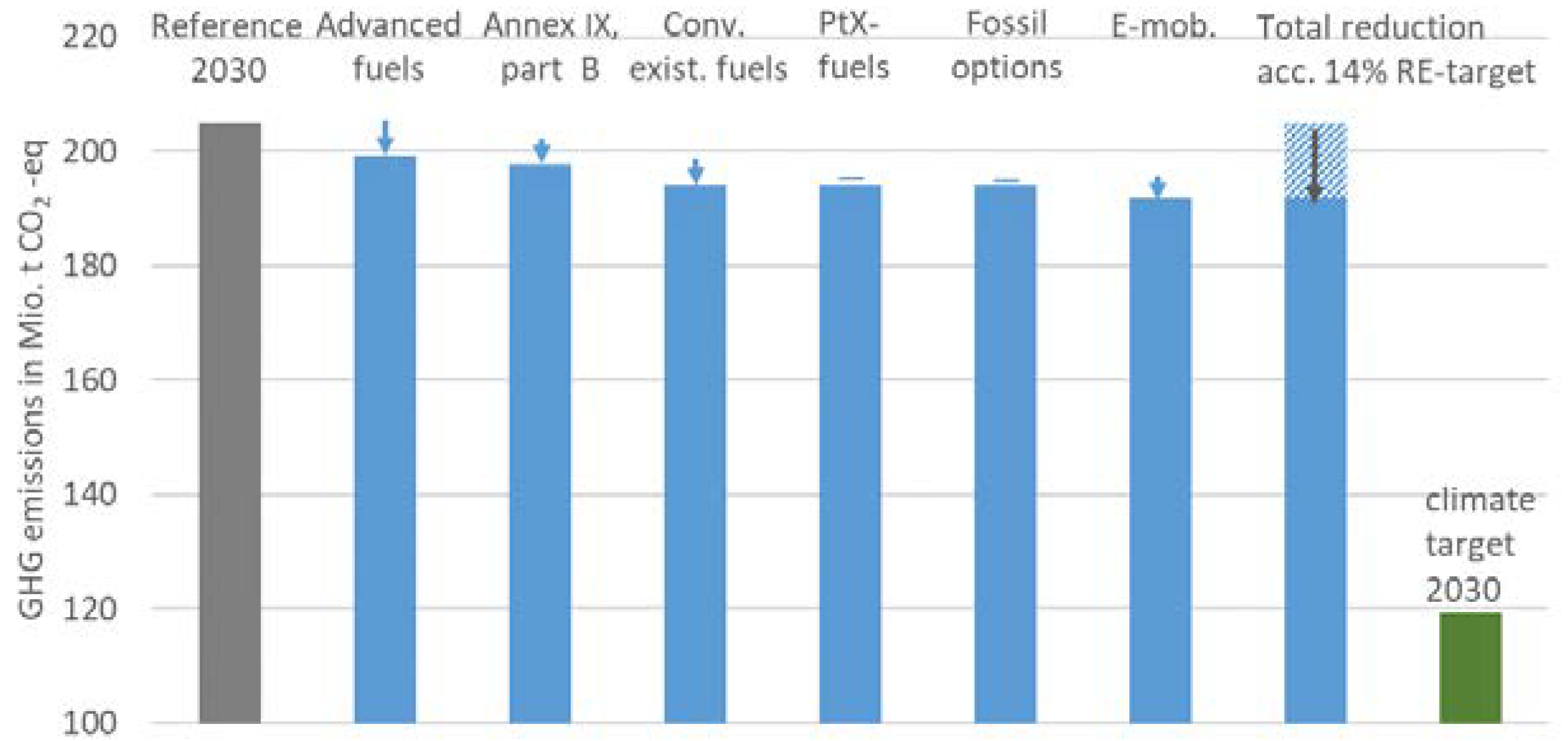
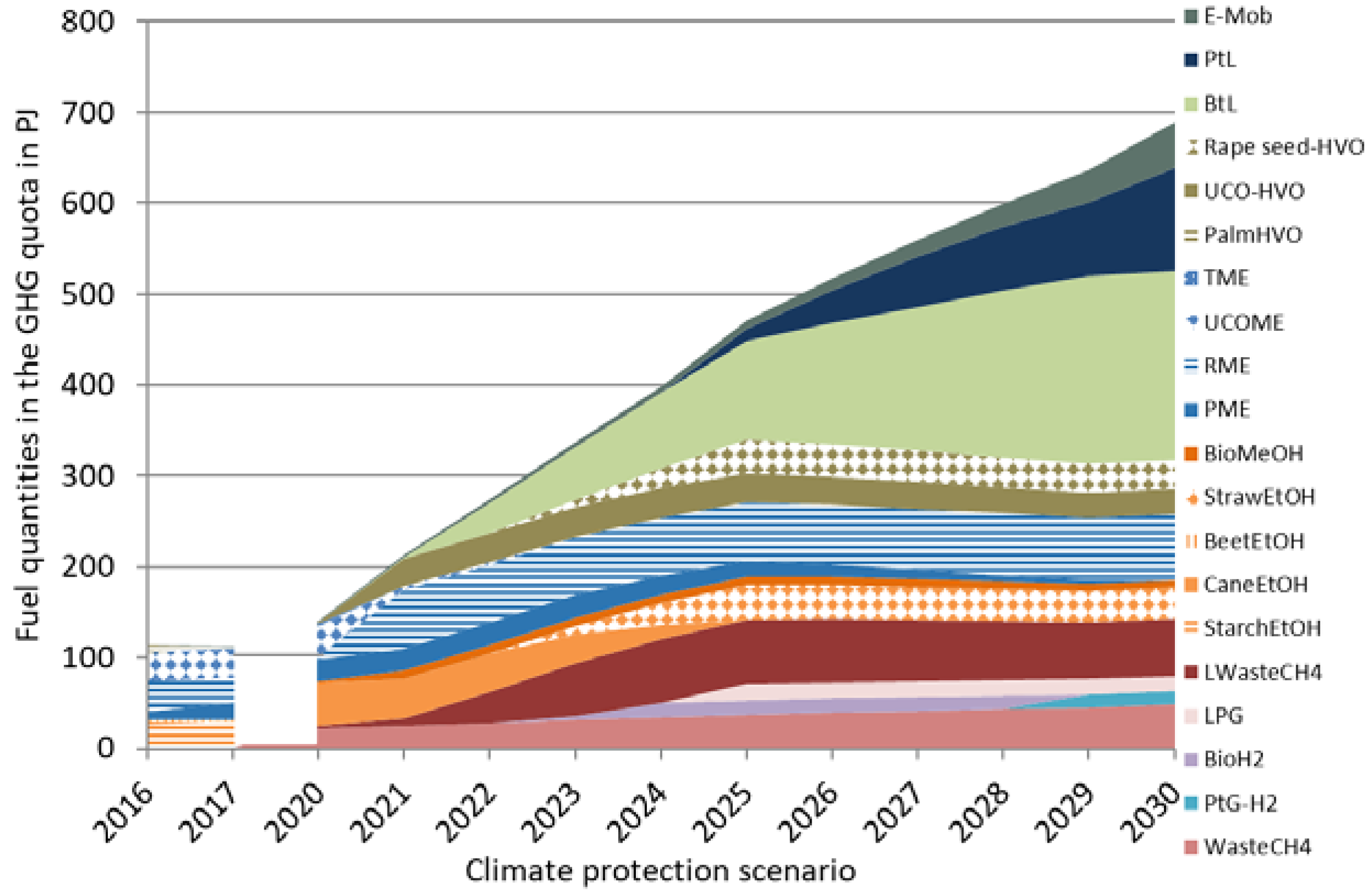

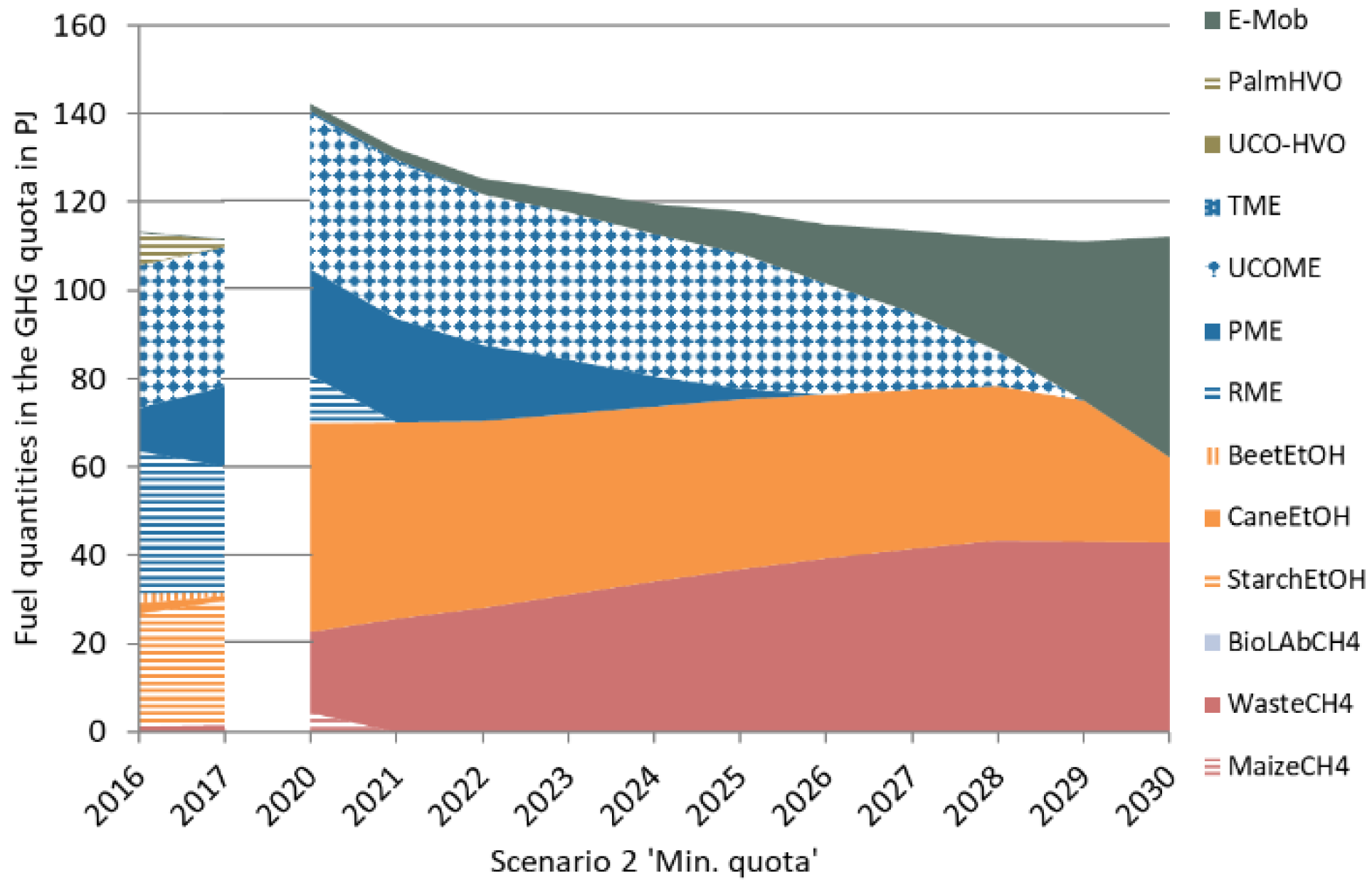
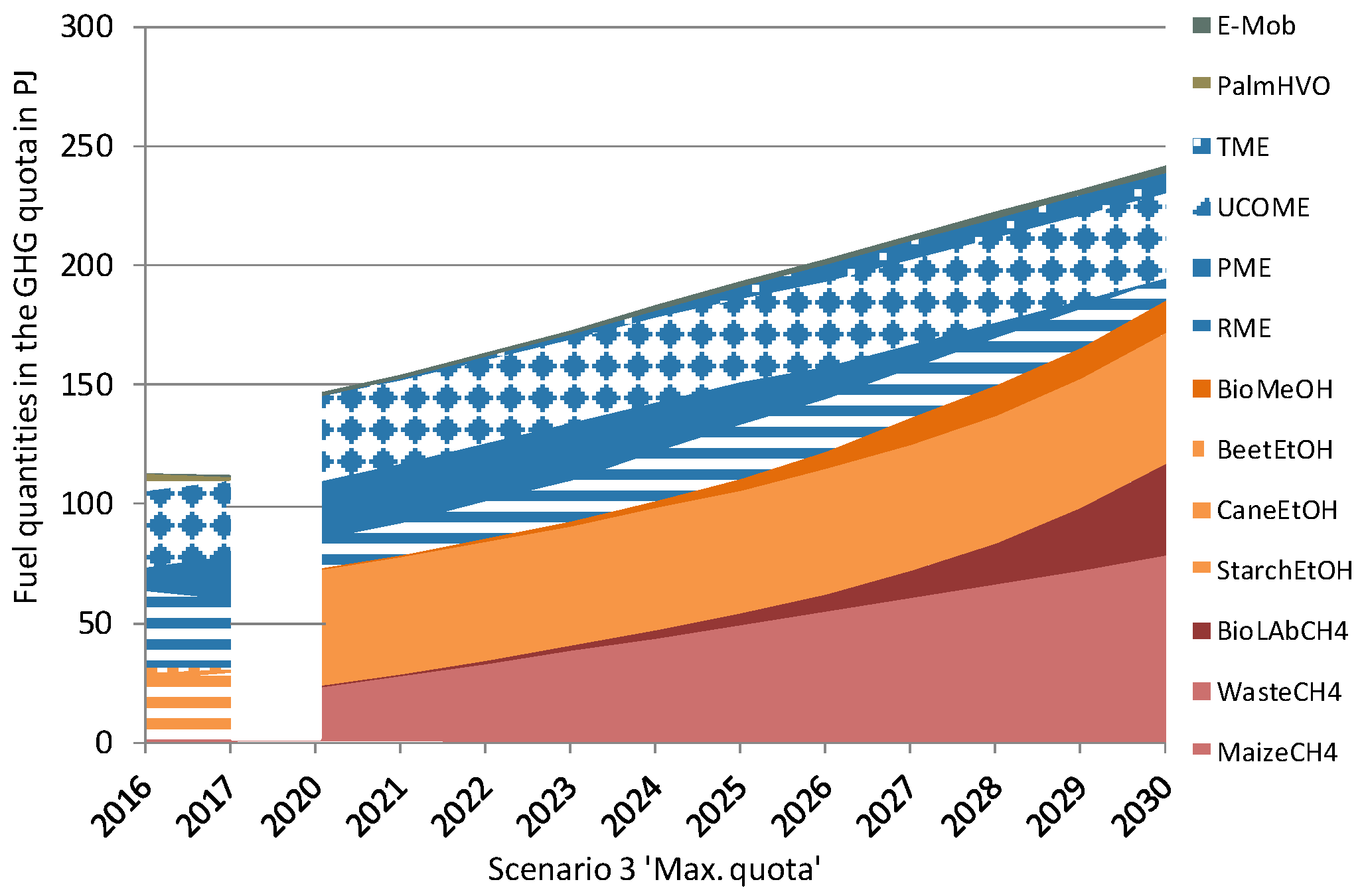
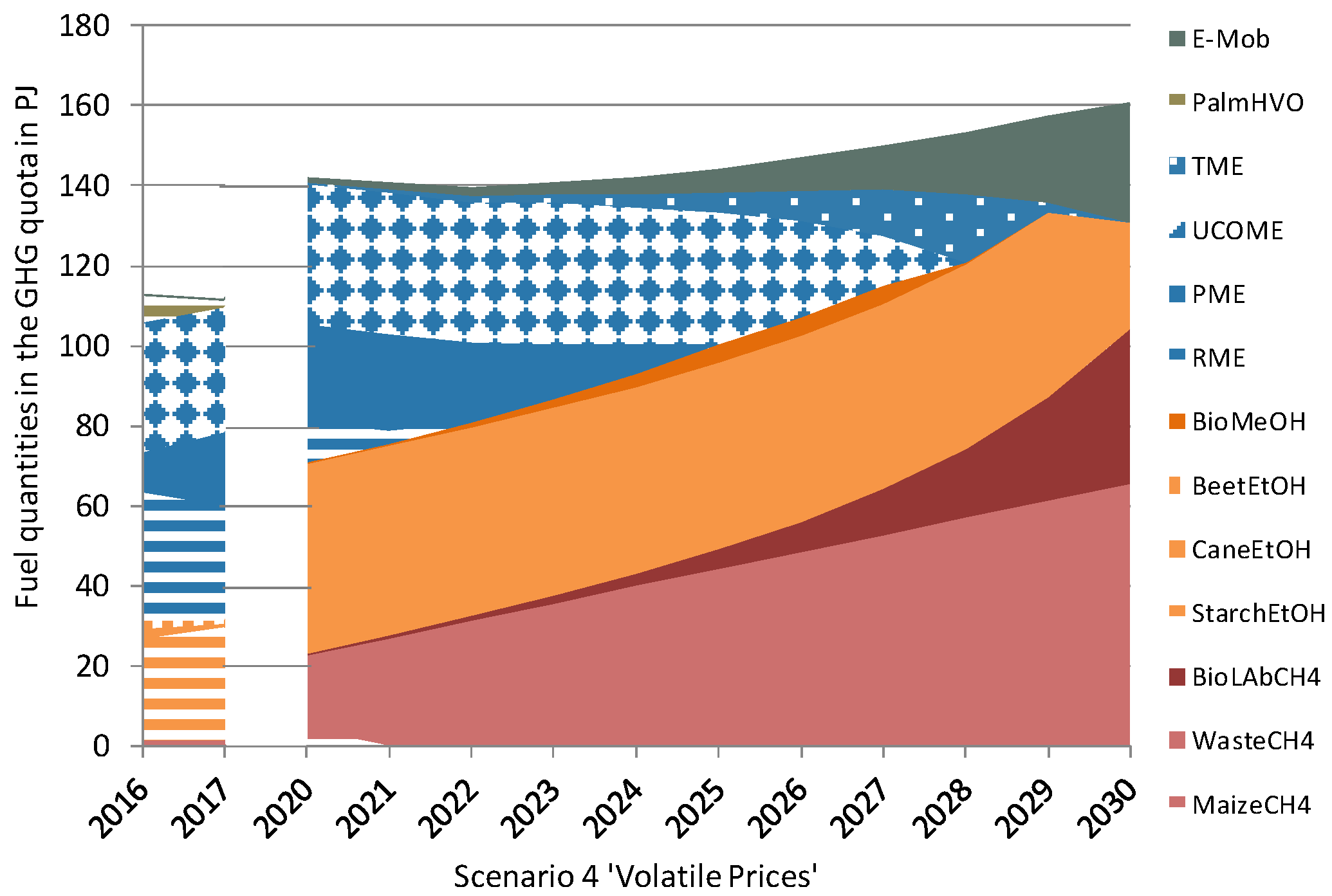
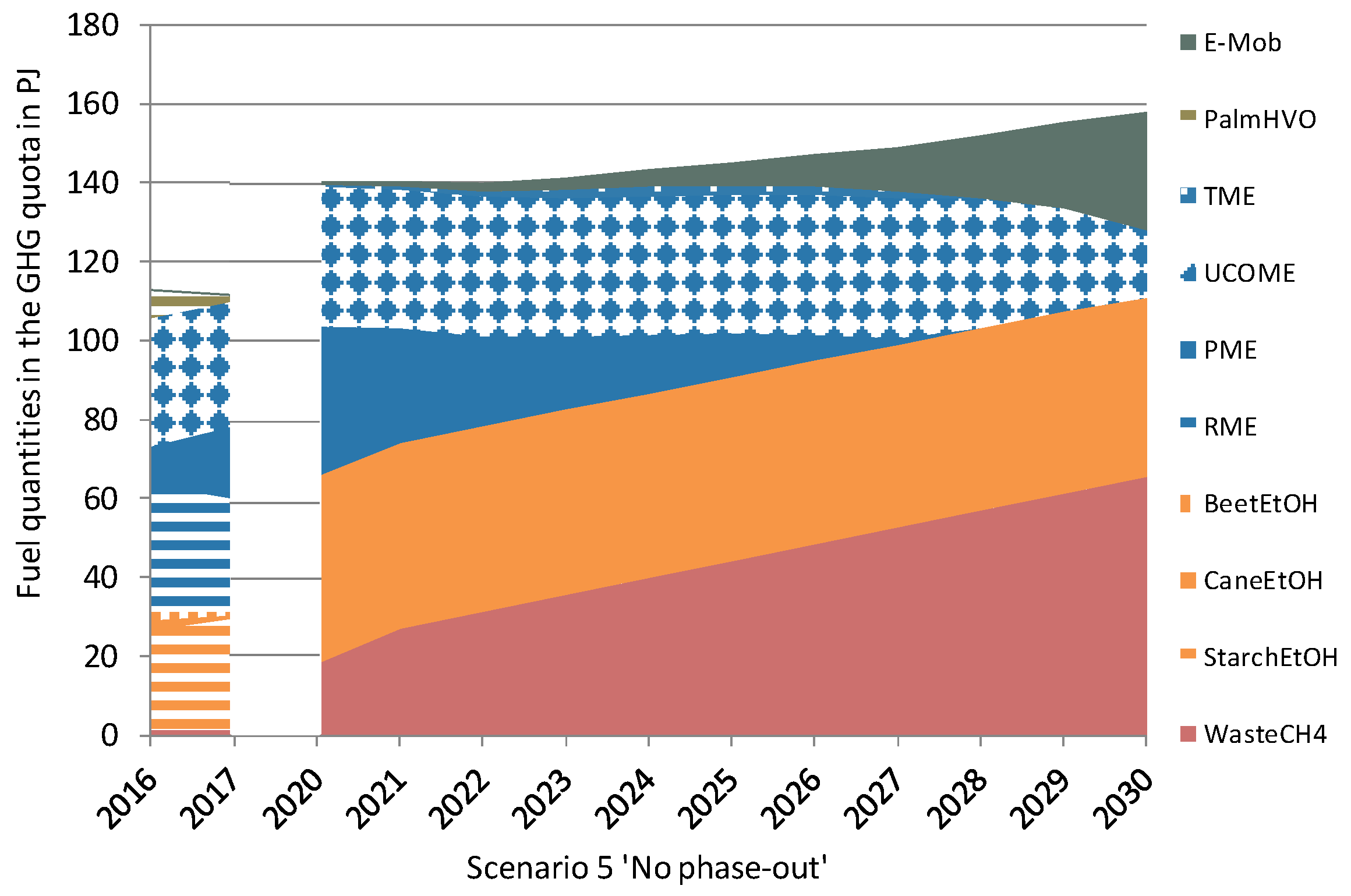

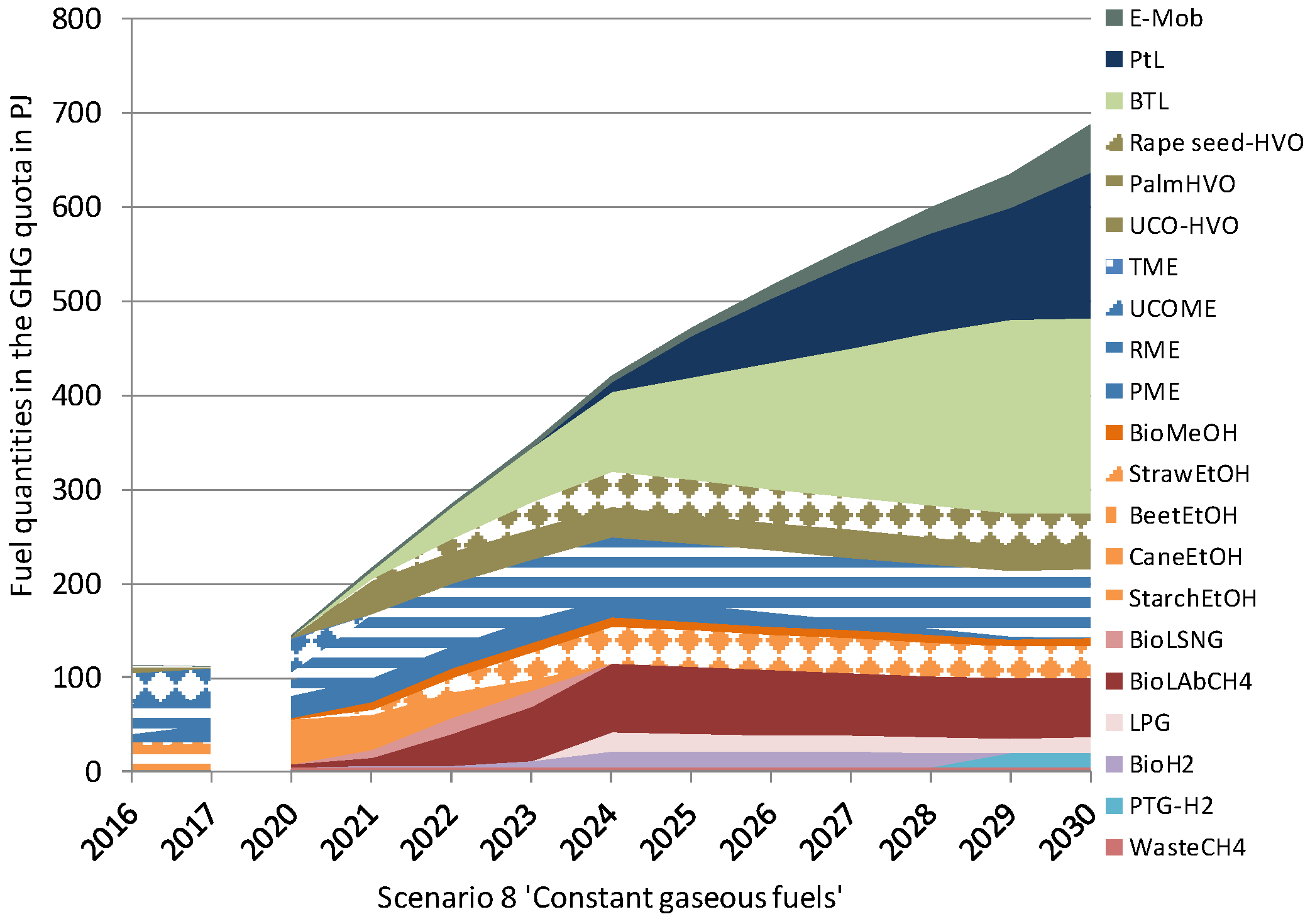
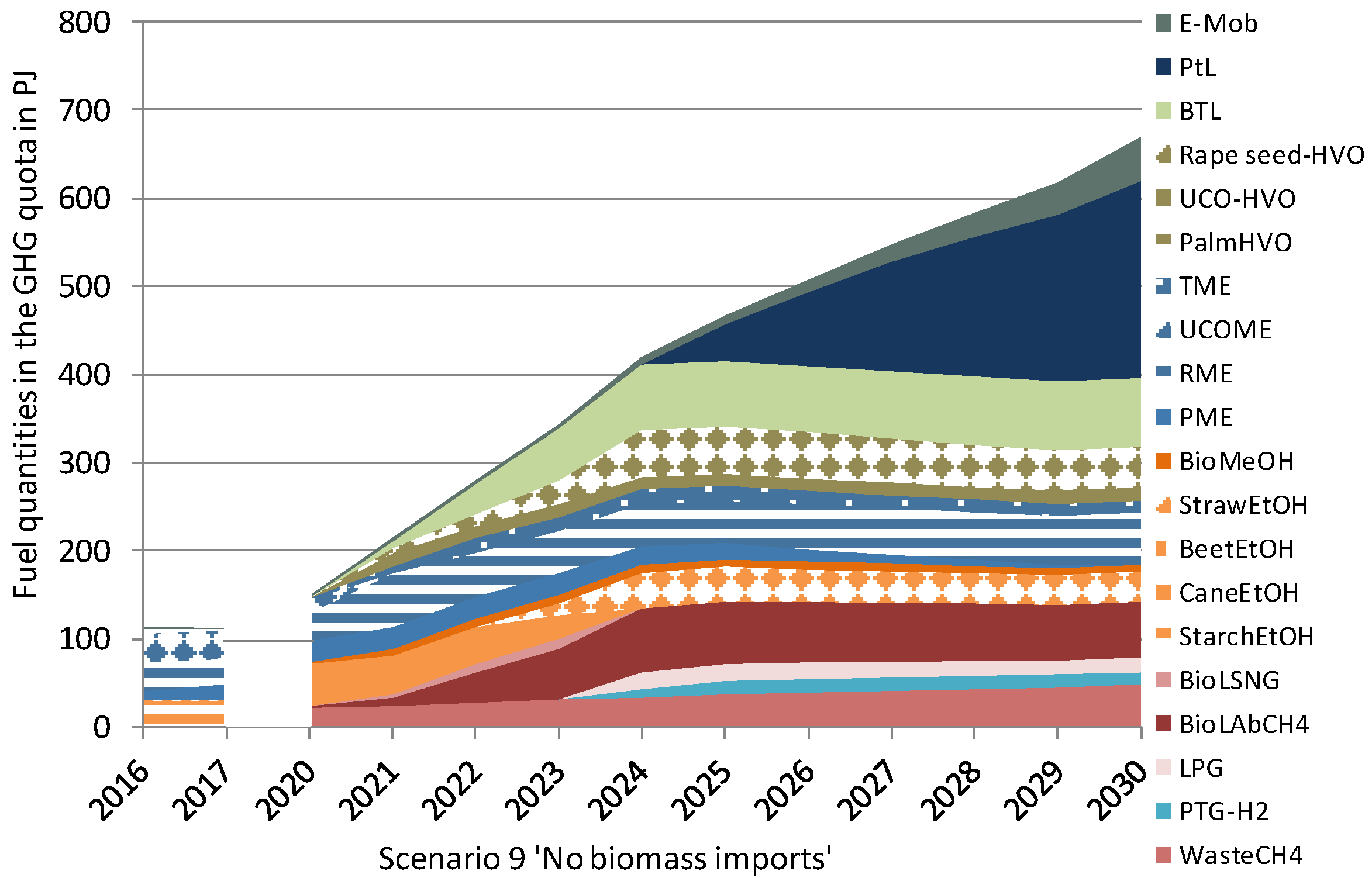
| Fuel Options | Biofuels from Food/Feed | Annex IX, Part A | Annex IX, Part B | Power to X | Fossil |
|---|---|---|---|---|---|
| Diesel fuels | |||||
| FAME (max. 7% vol.) | RME, PME, SoyFAME | UCOME, TME | |||
| HVO, BtL, PtL (max. 26% vol.) | Rape seed/ PalmHVO | BtL | UCO-HVO | PtL | |
| Petrol fuels | |||||
| Ethanol (max.10% vol.) | Beet/Starch/-CaneEtOH | StrawEtOH | |||
| Methanol (max. 3% vol.) | BioMeOH | ||||
| Gas fuels | |||||
| Gaseous fuels (max. 1-3% FEC) | MaizeCH4 | SNG, WasteCH4 | PtG-CH4 | CNG | |
| LPG (max. 1% FEC) | LPG | ||||
| Liquid methane (max. 3.9% FEC) | LSNG, LWaste4 | LNG | |||
| Hydrogen (max. 0.9% FEC) | Bio-H2 | PtG-H2 |
| Feature for 2030 | Baseline Scenario S1 | Climate Protection Scenario S6 |
|---|---|---|
| Regulation | RED II | RED II, Climate protection plan |
| Target | 14% renewable energies | 40% GHG reduction ct.1990 |
| FEC (PJ) | 2178 | 1620 |
| Electric mobility (PJ) | 30 (6 Mio. vehicles) | 50 (10 Mio. vehicles) |
| RE in electricity mix (%) | 55 | 65 |
| Model GHG quota (%) (w/o UER, electricity in rail traffic) | 5.3 | 32.5 |
| Feature for 2030 | S2 | S3 | S4 | S5 | S7 | S8 | S9 |
|---|---|---|---|---|---|---|---|
| Target | 14% RE | 14% RE | 14% RE | 14% RE | 40% GHG red. | 40% GHG red. | 40% GHG red. |
| FEC (PJ) | 1620 | 2614 | 2178 | 2178 | 1620 | 1620 | 1620 |
| Electric mobility (PJ) | 50 | 3 | 30 | 30 | 50 | 50 | 50 |
| RE in electri-city mix (%) | 65 | 45 | 55 | 55 | 65 | 65 | 65 |
| Model GHG quota (%) | 3.5 | 8.1 | 5.3 | 5.3 | 32.5 | 32.5 | 32.5 |
| Characteristic | Min. Quota | Max. Quota | Volatile prices | No phase out | No blending limit | Const. gaseous fuels | No biomass imports |
© 2020 by the authors. Licensee MDPI, Basel, Switzerland. This article is an open access article distributed under the terms and conditions of the Creative Commons Attribution (CC BY) license (http://creativecommons.org/licenses/by/4.0/).
Share and Cite
Meisel, K.; Millinger, M.; Naumann, K.; Müller-Langer, F.; Majer, S.; Thrän, D. Future Renewable Fuel Mixes in Transport in Germany under RED II and Climate Protection Targets. Energies 2020, 13, 1712. https://doi.org/10.3390/en13071712
Meisel K, Millinger M, Naumann K, Müller-Langer F, Majer S, Thrän D. Future Renewable Fuel Mixes in Transport in Germany under RED II and Climate Protection Targets. Energies. 2020; 13(7):1712. https://doi.org/10.3390/en13071712
Chicago/Turabian StyleMeisel, Kathleen, Markus Millinger, Karin Naumann, Franziska Müller-Langer, Stefan Majer, and Daniela Thrän. 2020. "Future Renewable Fuel Mixes in Transport in Germany under RED II and Climate Protection Targets" Energies 13, no. 7: 1712. https://doi.org/10.3390/en13071712





